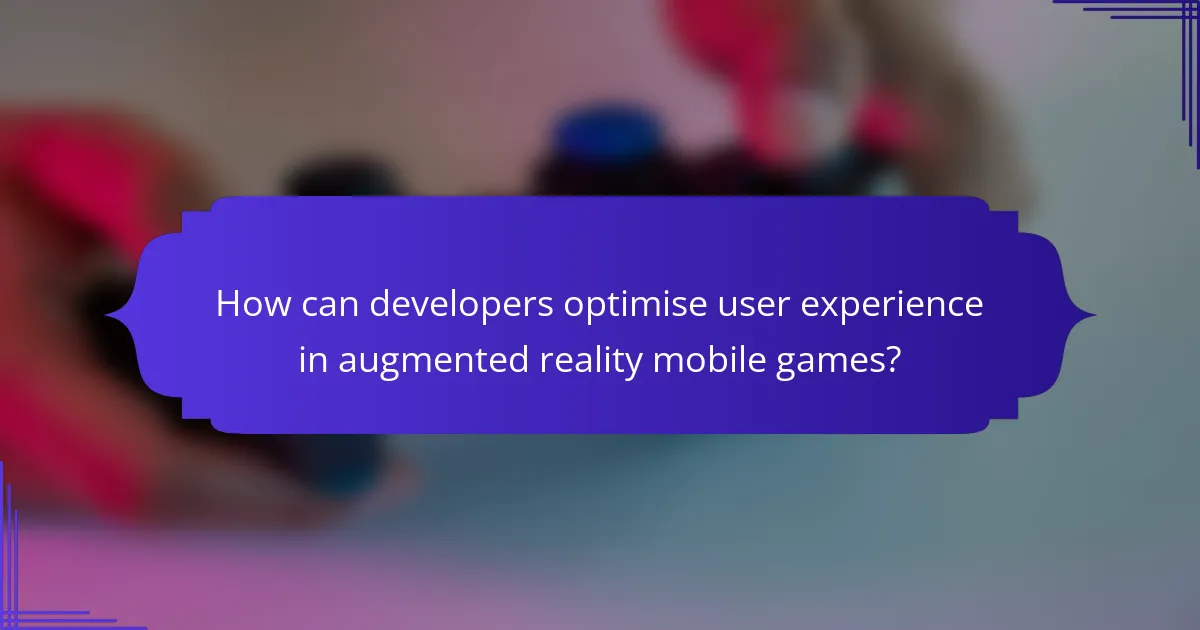Augmented reality in mobile games enhances user engagement and creates immersive experiences, but it also presents significant challenges for developers. This article explores the benefits of interactive gameplay and social interaction, the hurdles of hardware limitations and user experience, and strategies to optimize player satisfaction. By examining unique and rare attributes, we highlight how AR can transform mobile gaming while addressing the need for seamless integration and user privacy.

What are the key benefits of augmented reality in mobile games?
Augmented reality in mobile games enhances user engagement, promotes social interaction, and creates immersive experiences. These benefits transform gameplay by integrating digital elements into the real world.
Increased engagement arises from interactive gameplay, which keeps players invested. Social interaction is enriched as players collaborate or compete in shared environments. Immersive experiences allow users to explore virtual elements in real-world settings, deepening their connection to the game.
Moreover, augmented reality can improve learning outcomes in educational games by making complex concepts tangible. This unique attribute fosters both entertainment and education, appealing to diverse audiences.
As augmented reality technology advances, its potential to revolutionise mobile gaming continues to grow, promising innovative gameplay experiences.
How does augmented reality enhance user engagement?
Augmented reality enhances user engagement by creating immersive experiences that blend digital elements with the real world. This technology fosters interaction, increases retention, and promotes social sharing among players. For example, mobile games like Pokémon GO encourage players to explore their surroundings, enhancing physical activity and community interaction. As a result, augmented reality transforms traditional gaming by making it more dynamic and socially engaging.
What impact does augmented reality have on gameplay experience?
Augmented reality significantly enhances gameplay experience by creating immersive environments and interactive elements. Players engage more deeply with the game world, leading to increased enjoyment and retention. This technology fosters social interaction, as players often collaborate or compete in shared augmented spaces. Additionally, AR can provide real-time information and feedback, improving strategy and decision-making during gameplay. Overall, the integration of augmented reality transforms traditional gaming into a dynamic and engaging experience.
Which demographic groups benefit most from augmented reality in mobile gaming?
Younger audiences, particularly children and teenagers, benefit most from augmented reality in mobile gaming. This demographic is highly engaged with technology and enjoys interactive experiences. Augmented reality enhances social interaction, education, and immersive gameplay for these users. Additionally, adults in their 20s and 30s also experience significant benefits, as they seek novel gaming experiences that blend the virtual and real worlds.

What challenges do developers face when implementing augmented reality in mobile games?
Developers face several challenges when implementing augmented reality in mobile games. Key issues include hardware limitations, such as insufficient processing power and battery life, which affect performance. User experience can suffer due to varying device capabilities, resulting in inconsistent gameplay. Additionally, creating engaging content that seamlessly integrates AR features requires significant development resources and expertise. Ensuring accurate tracking and interaction within diverse environments presents another technical hurdle. Finally, maintaining user privacy and data security is crucial, as AR applications often rely on location and personal data.
How do technical limitations affect augmented reality experiences?
Technical limitations significantly hinder augmented reality experiences in mobile games. These limitations include hardware constraints, software compatibility issues, and network connectivity problems. For example, lower processing power impacts graphics rendering and responsiveness. Inadequate sensors can limit motion tracking accuracy, while poor internet connectivity can disrupt real-time interactions. As a result, these factors can lead to reduced user engagement and overall satisfaction. Addressing these challenges is crucial for enhancing the immersive quality of augmented reality games.
What are the common user interface challenges in augmented reality games?
Common user interface challenges in augmented reality games include navigation difficulties, inconsistent user experiences, and limited spatial awareness. Players often struggle with integrating virtual elements into their real-world environment. This can lead to frustration and decreased engagement. Additionally, the varying performance of devices can impact the quality of the augmented experience. Ensuring intuitive controls and minimizing distractions are crucial for enhancing user interaction in these games.
How do privacy concerns influence augmented reality game design?
Privacy concerns significantly influence augmented reality game design by prioritising user data protection. Developers must implement robust privacy measures to gain user trust. This includes transparent data usage policies and minimising data collection. Games that respect user privacy can enhance user experience and engagement. As a result, balancing immersive gameplay with ethical data practices is essential for success in augmented reality gaming.

What unique attributes set successful augmented reality mobile games apart?
Successful augmented reality mobile games stand out due to their immersive experiences, innovative gameplay mechanics, and social interaction features. Unique attributes include seamless integration of digital elements into the real world, real-time user interaction, and location-based gaming that enhances engagement. These aspects create a more compelling user experience, driving player retention and satisfaction. Additionally, unique storytelling and community-building elements differentiate these games in a competitive market.
Which innovative features enhance player immersion in augmented reality games?
Innovative features that enhance player immersion in augmented reality games include realistic environmental interactions, social connectivity, and adaptive gameplay mechanics. These elements create a seamless blend of the virtual and real worlds, increasing engagement. For example, location-based challenges encourage exploration of physical spaces, while customisable avatars foster personal connections. Enhanced sensory feedback, such as haptic responses, further deepens the immersive experience.
How do location-based elements differentiate mobile AR gaming experiences?
Location-based elements significantly enhance mobile AR gaming experiences by creating immersive environments tailored to real-world settings. These elements enable players to interact with digital content overlaid on their physical surroundings. For instance, location data can trigger unique in-game events, encouraging exploration and social interaction. This localised engagement fosters a sense of community and competition among players, enriching user experience. Additionally, location-based mechanics can offer personalised content, adapting gameplay to individual preferences and geographical contexts. Overall, these elements differentiate mobile AR games by blending reality with interactive storytelling.

What are the rare attributes of augmented reality in mobile gaming that enhance its appeal?
Rare attributes of augmented reality in mobile gaming include real-time environmental interaction, personalised experiences, and social integration features. These elements enhance user engagement by creating immersive gameplay that adapts to individual surroundings and fosters community connections. Additionally, unique visual overlays provide players with contextual information, enriching the overall gaming experience.
How do cultural themes influence augmented reality game narratives?
Cultural themes significantly enhance augmented reality game narratives by providing relatable contexts for players. They influence storylines, character development, and gameplay mechanics, creating immersive experiences. For instance, integrating local folklore can deepen player engagement and foster community connections. Additionally, cultural themes can shape user experiences by reflecting diverse perspectives, thus appealing to a broader audience. This cultural integration can lead to unique attributes in gameplay, such as localised challenges or culturally relevant rewards, enriching the overall narrative and user interaction.
What role do partnerships with local brands play in augmented reality games?
Partnerships with local brands enhance augmented reality games by providing authentic experiences and localised content. These collaborations create unique in-game events and promotions that resonate with players. Local brands contribute to community engagement, fostering loyalty and enhancing user experience. Additionally, they can offer exclusive rewards, driving user retention and increasing game visibility.

How can developers optimise user experience in augmented reality mobile games?
Developers can optimise user experience in augmented reality mobile games by focusing on intuitive controls, engaging narratives, and seamless integration with real-world environments. Prioritising user feedback enhances gameplay and fosters community engagement.
Effective use of spatial awareness allows for immersive experiences that feel natural. Regular updates and enhancements based on user analytics can address challenges and improve retention rates. Additionally, incorporating social features encourages player interaction, further enriching the overall experience.
What best practices should developers follow for effective augmented reality design?
Developers should prioritise user experience, intuitive controls, and realistic graphics in augmented reality design. Effective AR design enhances immersion and engagement while minimising user frustration.
1. Focus on intuitive user interfaces that facilitate easy navigation and interaction.
2. Ensure high-quality graphics that blend seamlessly with the real world, enhancing realism.
3. Optimise performance to prevent lag and maintain a smooth experience.
4. Incorporate feedback mechanisms to gather user insights and improve the design iteratively.
5. Test designs in various environments to ensure consistent performance across different settings.
Which common mistakes should be avoided when creating augmented reality games?
Avoiding common mistakes in augmented reality games is crucial for success. Key errors include neglecting user experience, failing to optimise for various devices, and overlooking the importance of clear instructions. These issues can lead to frustration and disengagement. Additionally, ignoring the balance between virtual and real-world elements can diminish immersion, while inadequate testing may result in bugs that disrupt gameplay. Addressing these factors enhances overall user engagement and satisfaction.
How can user feedback be effectively integrated into augmented reality game development?
User feedback can be effectively integrated into augmented reality game development through iterative design and testing. Regularly collecting user insights allows developers to identify preferences and pain points. This feedback informs game mechanics, user interfaces, and overall user experience. Implementing a feedback loop ensures continuous improvement and engagement, ultimately enhancing player satisfaction.
